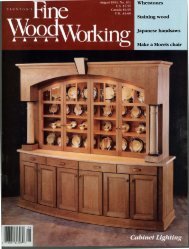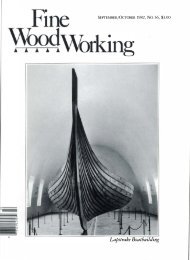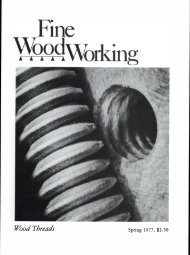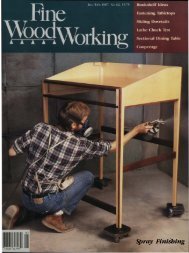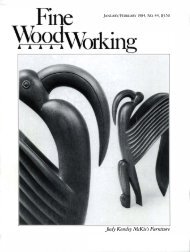NOVEMBER/DECEMBER 1983, No. 43, $3.50 Making ... - Wood Tools
NOVEMBER/DECEMBER 1983, No. 43, $3.50 Making ... - Wood Tools
NOVEMBER/DECEMBER 1983, No. 43, $3.50 Making ... - Wood Tools
Create successful ePaper yourself
Turn your PDF publications into a flip-book with our unique Google optimized e-Paper software.
________<br />
�Wrking_ ��::::::--:--���<br />
Fine<br />
Quick and Tricky Little Boxes<br />
__ <strong>No</strong>vember/December <strong>1983</strong><br />
How I bookmatch scrap wood into Christmas gifts by Jim Cummins<br />
I'm an impatient putterer with thrifty inclinations. Over the<br />
past year I've gotten a big kick out of converting my<br />
scrap pile into a bunch of Christmas presents. Inspired by<br />
Sam Bush's matched-grain box from FWW #32 (figure 1,<br />
facing page), I began exploring variations in the design and<br />
construction of small boxes, aiming to have fun while not<br />
making the same box twice. I ended up with a dozen variations,<br />
most of them figure-matched in one way or another,<br />
with different designs for lids and bottoms, and different joinety<br />
details. Some required a little thoughtful planning, some<br />
were last-minute adaptations based on chance, and a couple<br />
of my favorite details grew out of my effortS to fix mistakes.<br />
The elements can be combined in lots of ways, and there isn't<br />
a box here that can't be made in an hour or two, not counting<br />
the finishing, of course.<br />
The ftrst variation-Sam Bush's box in figure 1 comes out<br />
of a board, but my first bookmatched box, shown in figure 2,<br />
came from a walnut rurning scrap about 2 in. square by 9 in.<br />
long. First I bandsawed it into four strips, and planed them<br />
smooth on both sides. On one pair of strips, I laid Out the<br />
32<br />
Square pegs in round holes pin<br />
these lapped corners.<br />
box sides and ends the same way Bush did. The other pair of<br />
strips I edge-glued, using masking tape to clamp the joint<br />
(p. 34). This bookmatched piece was as wide as the ends of<br />
the box, and long enough to cut in half to become the bottom<br />
and lid. While the strips dried, I rabbeted the top and<br />
bottom edges of the sides and ends as shown in figure 2A,<br />
then I mitered and glued them, again with tape, adding rubber<br />
bands for more pressure. While the sides cured, I rabbeted<br />
the lid and the bottom to fit into the rabbets in the sides. I<br />
glued the bottom in, using tape clamps, put the lid on and<br />
sanded the edges flush.<br />
When I was done, I realized that I'd made three dumb<br />
mistakes. First, I hadn't examined the direction of the grain<br />
in the turning square. Bookmatching, because of the sawkerf,<br />
is never perfect, but if you arrange the grain as shown in<br />
figure 2B, it will be close. I had sawn the blank at an intermediate<br />
angle to the annual rings, which gave me pretty<br />
wood, but a poor match. My second mistake was in jointing<br />
and thicknessing the stock before I joined the sides. Bookmatched<br />
figure matches best right at the sawkerf, so you want<br />
to remove minimum wood from the show surfaces. I should<br />
Splined boxes of red maple,<br />
spalted hackberry, and cherry.



